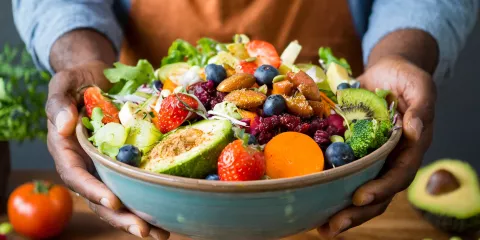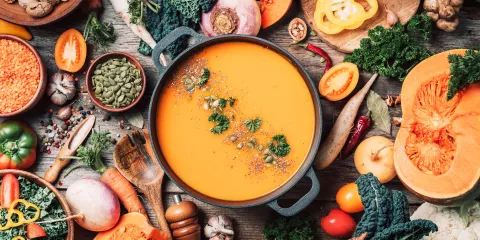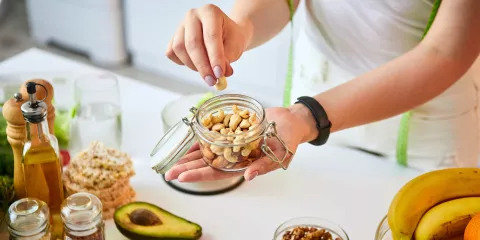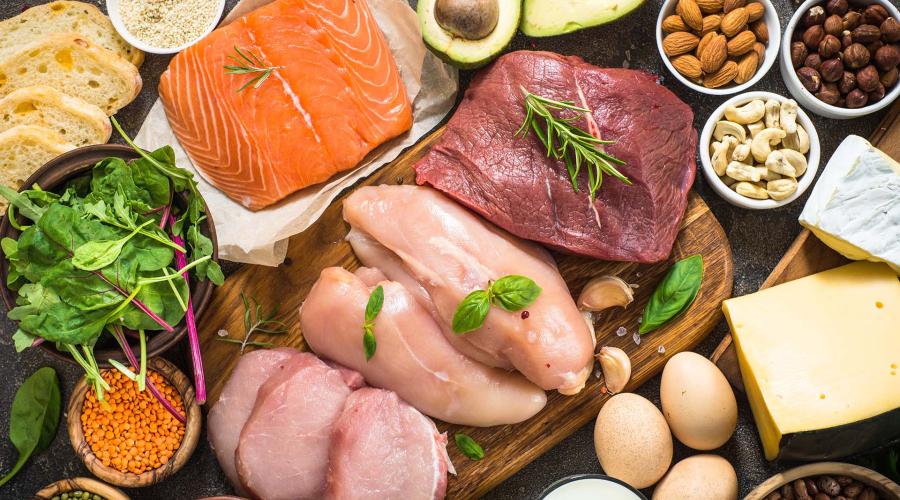
Meal Plan Created By: Amanda Kostro Miller
Trying new food and incorporating meals you don’t always eat into your diet has been proven to be healthier than meals which consistently share the same food groups.1,2 But too often, the words “healthy eating” and “diet” conjure up images of lone salad leaves on a barren plate, or worse, less meals in general.
ICYMI: 12 Months of Healthy Eating: One Pot Ingredient Meals
There are plenty of ways to eat heartily and with heart health in mind. This month, as part of our 12 Months of Healthy Eating, we’re crushing cravings with a meal plan that’s hearty and delicious, and offering up tips for bulking up your health. If your stomach is rumbling, we don’t blame you! Download our free, weeklong meal plan built by a Registered Dietician, and let’s get cooking!
Download The Printable Meal Plan
Tricks to Make Hunger-Buster Meals Work for You
Filling Yourself Up Can Curb Excess Hunger
The trick to healthy filling meals is to understand the difference between what nutritionists call “empty calories” and “good calories.”3 At its most basic definition, the term “empty calories” refers to foods that either do not have any significant nutritional value, or foods whose fat and sugar content outweighs the nutritional benefits provided by that food. So, for instance, candy bars are typically considered empty calories, rather than good calories, which contribute to the processes which sustain us physically as humans. While there are several factors that influence dietary choices, often, Americans reach for pre-made, pre-packaged foods which can be high in sodium, sugar, and fat because we feel we do not have time to make our own meals at home.4,5,6
This meal plan aims to simplify the cooking process for foods which are packed with nutrients that are more filling and meaningful than most food at gas stations, fast-food restaurants, and other places we feel we can snag a quick and easy, but not necessarily nutritious meal. Of the “good calories” one can have, foods which are high in protein and high in fiber, such as vegetables, fruits and whole grains, work especially hard to keep us feeling full and satiated throughout the day.7 This is why our hunger-busting meal plan is full of foods like salmon, beef, and nuts, as well as vegetables, beans, and avocado.
Related: 7 Important Nutrients You Can’t Miss
Staying Hydrated is Key
While it may seem unrelated, how well you keep yourself hydrated during the day has an enormous effect on how full you feel. Drinking enough water not only curbs the urge to snack throughout your day, but can also aid in a myriad of biological processes like reducing the frequency of headaches, fending off fatigue, and keeping your digestive system more regular. Studies show that the average adult should drink 11-16 cups of water per day,8 so don’t forget to drink up! If you’re feeling snacky, a good trick is to make yourself drink a whole glass of water. If you’re still hungry after polishing off the glass, grab a healthy snack, like those included in this month’s meal plan. If you find it difficult to remember to stay hydrated, try setting a reminder on your phone, carrying water with you wherever you go, or buying a hydration tracking water bottle. Drinking more water can not only help you feel less hungry throughout the day, but also help you feel more healthy, too.
Keep Your Emotions in Mind
Hunger, like stress, also can be an indicator that something greater is going on with your physical and mental well-being. If you’re constantly hungry, consider whether you’re getting enough good sleep, or whether you’re going through a rough time emotionally. After all, there’s a reason we call it “comfort food.” If you find that you’re often eating to calm yourself down or make yourself feel better, try substituting food with another avenue of self-care, like getting a massage, going for a run, or taking a moment to let yourself do an activity you find soothing or fun. Be conscious of how you reward yourself, and how you make yourself feel better. And if you must eat to help regulate your emotions, be aware of which snacks you’re reaching for—try to snag a protein pack composed of nuts, seeds, and lean meat rather than opting for a pint of ice cream or a handful of cookies. Keeping track of your emotional state will also help you regulate your hunger over the course of the day.
Related: At Home Self-Care Checklist
Healthy Recipes for Hunger-Busting Meals
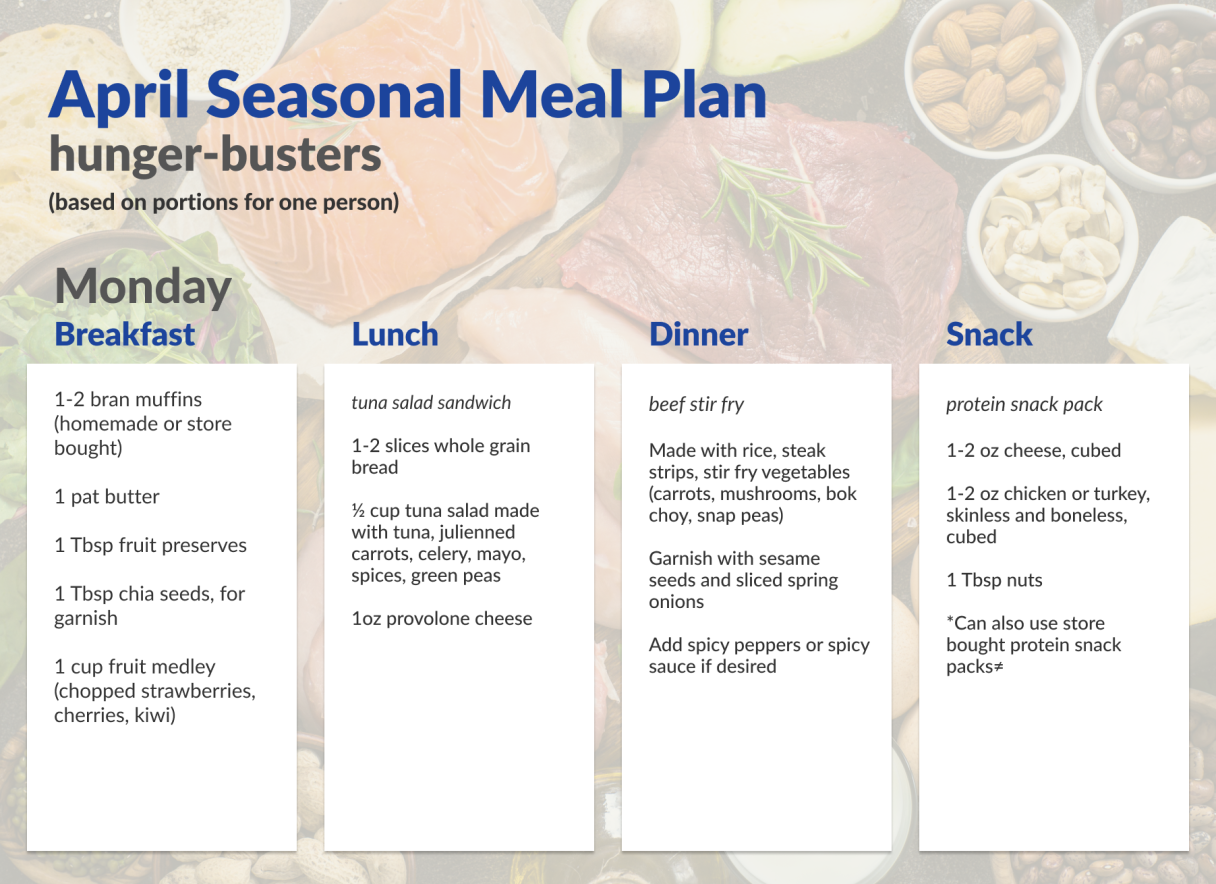
Ready to get cooking? Many heart-healthy recipes are just as tasty as they are easy to make. Our Registered Dietician specially developed this week-long meal plan to fill you up, with delicious breakfasts, lunches, dinners, and snacks designed to beat out hunger and keep your cravings at bay. Each recipe is as flavorful as it is nutritious. Try the sumptuous chocolate peanut butter oatmeal for breakfast, or rock out on your lunch break with a spinach artichoke grilled cheese. There are so many mouth-watering options to try, but make sure to pace yourself! With these full meals on hand, you might spoil your appetite!
Hungry for more heart-healthy meal ideas? Download our heart-healthy cookbook for a dozen more quick and easy dinners to try out.
References
1 https://health.clevelandclinic.org/eating-the-same-thing-every-day-4-reasons-to-increase-variety/
2 https://time.com/3675098/healthy-diet-plans-variety/
3 https://www.houstonmethodist.org/blog/articles/2021/jan/empty-calories-what-are-they-and-which-foods-are-they-hiding-in/
4 https://www.onhealth.com/content/1/weight_loss_diet_hunger_causes
5 Asp E. Factors affecting food decisions made by individual consumers. Food Policy. 1999;24:287–294. doi: 10.1016/S0306-9192(99)00024-X.
6 https://www.mayoclinic.org/healthy-lifestyle/nutrition-and-healthy-eating/in-depth/cook-at-home-this-week/art-20269951
7 https://www.mayoclinic.org/healthy-lifestyle/weight-loss/in-depth/weight-loss/art-20044318
8 https://www.hsph.harvard.edu/news/hsph-in-the-news/the-importance-of-hydration/

